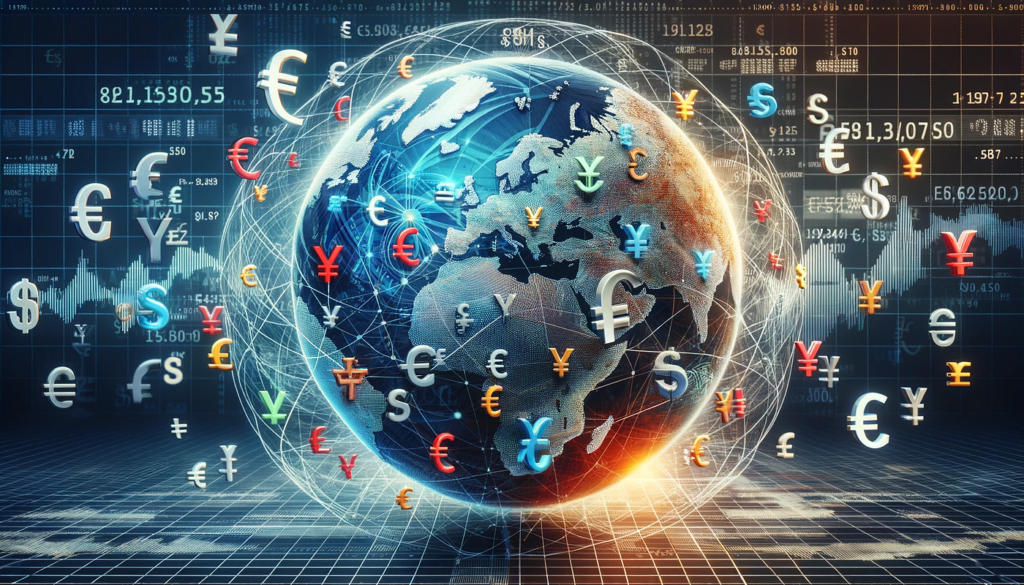Forex
- Home
- Forex

What is forex?
Forex trading, also known as foreign exchange or FX trading, is the conversion of one currency into another. FX is one of the most actively traded markets in the world, with individuals, companies and banks carrying out around $6.6 trillion worth of forex transactions every single day.
The amount of currency converted every day can make price movements of some currencies extremely volatile – which is something to be aware of before you start forex trading.
The forex market’s huge
Forex is the world’s most traded market with over $7.5 trillion* being traded every day. To put it in perspective, the daily average volume for the S&P 500 is only $553 billion (2.27% of the size of forex)**
You’ve probably already traded FX
When you travel to another country, you usually exchange your money into the foreign currency to spend money there. Sometimes, whatever you don’t end up spending you’ll convert back. This is forex.
Currencies come in pairs
You’re always trading one currency against another, such as the US dollar against the Canadian dollar (USD/CAD). This is called a forex pair.
There are always potential opportunities
Forex is an exceptionally liquid market, and it’s reacting all the time. This makes it especially attractive to day traders looking for short-term wins.
There’s no centralized exchange
Unlike stocks which use exchanges such as the New York Stock Exchange, forex is traded by a decentralized global network of banks.
The FX market never sleeps
You can trade forex 24 hours a day, 5 days a week, from Sunday 5PM to Friday 5PM. This is because the time zones of the four trading centers (London, New York, Sydney, and Tokyo) overlap with each other. So, when one closes, another opens.
*average daily volume from the BIS 2022 Triennial FX Report
**2022 average daily volume from Statista
How forex trading works
Before we dig into the details, let’s take a look at a simplified forex trade as an example.
Trading EUR/USD
You believe that the value of the euro will rise against the US dollar, because the EU reported strong economic growth.
So, you buy EUR/USD, meaning you’re buying euros while selling the US dollar.
Scenario 1: you are correct
Your analysis was spot on and the euro rises against the dollar.
Your position increases in value and you decide to close your trade and take your profit.
Scenario 2: you are incorrect
The markets don’t react the way you anticipated, and the euro falls against the dollar.
Your position decreases in value, you decide to close your trade and take your loss.
Understanding currency pairs
Forex is always traded in currency pairs, such as AUD/USD. This is because a currency cannot be speculated against itself; its value is always in relation to another currency.
But why does the AUD/USD pair look the way it does?
Every currency in forex trading is signified by three letters. These are known as the ISO 4217 Currency Codes.
The first two letters denote the country. The third represents the currency name.
- AUD = Australia dollar
- USD = United States dollar
Forex currency pair nicknames
As you become immersed in the world of forex, the currency pairs are often referred to by their nicknames. Here are just a few:
- GBP/USD – Cable
- EUR/CHF – Swissy
- EUR/USD – Fiber
- EUR/GBP – Chunnel
- NZD/USD – Kiwi
Types of currency pairs
FX pairs are categorized into three types: majors, minors, and exotics.
Major currency pairs
As the name suggests, the ‘majors’ are the most popular traded currency pairs. They account for around 85% of the total FX trading volume and are represented by some of the world’s largest economies.
About a quarter of all forex trades are in EUR/USD.
- EUR/USD – the euro vs the US dollar
- USD/JPY – the US dollar versus the Japanese yen
- GBP/USD – British pound sterling versus the US dollar
- AUD/USD – the Australian dollar versus the US dollar
- USD/CHF – the US dollar versus the Swiss franc
- USD/CAD – the US dollar versus the Canadian dollar
As they are so regularly traded, you’ll typically find the major pairs to have the tightest spreads (the difference between the sell and the buy prices). This makes them less costly to trade than other forex pairs.
Minor currency pairs
Minor pairs are currency pairs that don’t include the US dollar. They are also known as cross pairs.
Examples include:
- EUR/GBP – the euro versus British pound sterling
- EUR/CHF – the euro versus the Swiss franc
- GBP/AUD – British pound sterling versus the Australian dollar
- GBP/JPY – British pound sterling versus the Japanese yen
- CAD/JPY – the Canadian dollar versus Japanese yen
- CHF/JPY – the Swiss franc versus the Japanese yen
- EUR/NZD – the euro versus the New Zealand dollar
As they are less traded than the major pairs (meaning the market is not as liquid), the spreads are usually wider than the major currency pairs.
Exotics
Exotic currency pairs consist of a major currency and a much less traded one, such as the US dollar versus the Chinese yuan (USD/CNH).
Many of the smaller currencies are from developing countries or small nations with strong economies. They often come with the largest spreads as they are the least traded type of pair.
Examples include:
- USD/MXN – the US dollar versus the Mexican peso
- USD/THB – the US Dollar versus the Thai Baht
- GBP/PLN – British pound sterling versus the Polish zloty
- GBP/SEK – British pound sterling versus the Swedish krona
- EUR/RON – the euro versus the Romanian leu
- EUR/RUB – the euro versus the Russian ruble
Exotic FX pairs are more suitable for experienced traders. Due to the economic and political instability of some nations, they present a greater risk (and potentially greater rewards) than the other pair types.